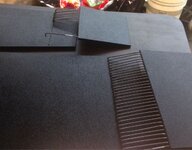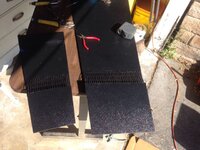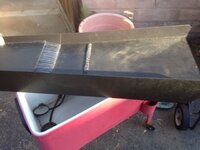Navigation
Install the app
How to install the app on iOS
Follow along with the video below to see how to install our site as a web app on your home screen.
Note: This feature may not be available in some browsers.
More options
You are using an out of date browser. It may not display this or other websites correctly.
You should upgrade or use an alternative browser.
You should upgrade or use an alternative browser.
goldog's fluid head blog.
- Thread starter goldog
- Start date
Goodyguy
Gold Member
- Mar 10, 2007
- 6,489
- 6,900
- Detector(s) used
- Whites TM 808, Whites GMT, Tesoro Lobo Super Traq, Fisher Gold Bug 2, Suction Dredges, Trommels, Gold Vacs, High Bankers, Fluid bed Gold Traps, Rock Crushers, Sluices, Dry Washers, Miller Tables, Rp4
- Primary Interest:
- All Treasure Hunting
Back at it this morning. Thinking about sizesA 30" Prospector is lined up. But I'm going to make some Sniper sized boxes as a production test. Any feedback as far as sizes would be helpful.
The Sniper is small. I just feel the trap needs to be bigger. Maybe an in between size. Just using round #s. A 30" with say 10 at the flare and 6 at the bottom. Vs 4.5" width of a Bazooka.
An extra 1 1/2 inches in both L&W might be good for the trap.
I favor a longer trap .....gives the gold more time to settle.
GG~
Last edited:
goldog
Hero Member
- Sep 25, 2012
- 923
- 987
- Detector(s) used
- Bazooka Gold Trap, A-51, Gold Pan
- Primary Interest:
- Prospecting
- Thread starter
- #63
That's my feeling too. I'm adding an inch or two to all the boxes.
I hadn't thought that much about it until looking at the description for the Sniper. A six inch width seems good. Ending up with 27x6->10x5. 6-7 inch trap on this one.
I'm leaning toward a complete clone. Other than size it will be a Bazooka. Back to the basics. Of course being the fluid head that I am...
I hadn't thought that much about it until looking at the description for the Sniper. A six inch width seems good. Ending up with 27x6->10x5. 6-7 inch trap on this one.
I'm leaning toward a complete clone. Other than size it will be a Bazooka. Back to the basics. Of course being the fluid head that I am...
Goodyguy
Gold Member
- Mar 10, 2007
- 6,489
- 6,900
- Detector(s) used
- Whites TM 808, Whites GMT, Tesoro Lobo Super Traq, Fisher Gold Bug 2, Suction Dredges, Trommels, Gold Vacs, High Bankers, Fluid bed Gold Traps, Rock Crushers, Sluices, Dry Washers, Miller Tables, Rp4
- Primary Interest:
- All Treasure Hunting
That's my feeling too. I'm adding an inch or two to all the boxes.
I hadn't thought that much about it until looking at the description for the Sniper. A six inch width seems good. Ending up with 27x6->10x5. 6-7 inch trap on this one.
Of course being the fluid head that I am...
I know what you mean. When I first got into fluid beds I was turning everything that would hold water into one, as well as trying out all sorts of fluidizing gizmos including experimenting with different types of lawn sprinklers and spray heads. I must have built at least 50-60 different styles and types of fluidbed traps including one out of an old mailbox.

Found out it's hard to build one that wont recover gold. It's shooting for perfection that makes it challenging.
For $2.98 at Lowes This works pretty good in the bottom of a bucket (face the spray down of course) I experimented drilling holes in the inside edge and outside edge too. Turns a bucket of sand into quicksand.
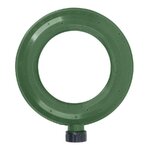
Had the idea of running several of them sideways in a large tube style trap but never tried it out...........
Might even work in a gold pan with a bilge pump attached to convert into a fluid bed gold pan. (panzooka)
GG~
Last edited:
goldog
Hero Member
- Sep 25, 2012
- 923
- 987
- Detector(s) used
- Bazooka Gold Trap, A-51, Gold Pan
- Primary Interest:
- Prospecting
- Thread starter
- #65
You know, I think a lot of us are in that same boat. We can't always get out to look for gold. But we can imagine how we'd get it. And we can build it. Unfortunately, everything seems to be a potential tool. Walking through the kitchen is a minefield.
Three bucks really?! Oh I've got an idea brewing...
Three bucks really?! Oh I've got an idea brewing...
Last edited:
mytimetoshine
Bronze Member
- Jun 23, 2013
- 1,574
- 3,372
- Detector(s) used
- GRIZZLY GOLD TRAP - ANGUS MACKIRK EXPLORER- BLUE BOWL - GOLD CUBE, MINELAB PRO 25 PINPOINTER-
- Primary Interest:
- All Treasure Hunting
that's what I pictured in my head for Panzooka! bilge pump connected to the panI know what you mean. When I first got into fluid beds I was turning everything that would hold water into one, as well as trying out all sorts of fluidizing gizmos including experimenting with different types of lawn sprinklers and spray heads. I must have built at least 50-60 different styles and types of fluidbed traps including one out of an old mailbox.
Found out it's hard to build one that wont recover gold. It's shooting for perfection that makes it challenging.
For $2.98 at Lowes This works pretty good in the bottom of a bucket (face the spray down of course) I experimented drilling holes in the inside edge and outside edge too. Turns a bucket of sand into quicksand.
View attachment 1438234
Had the idea of running several of them sideways in a large tube style trap but never tried it out...........
Might even work in a gold pan with a bilge pump attached to convert into a fluid bed gold pan. (panzooka)
GG~
Sent from my SAMSUNG-SM-G920A using Tapatalk
Goodyguy
Gold Member
- Mar 10, 2007
- 6,489
- 6,900
- Detector(s) used
- Whites TM 808, Whites GMT, Tesoro Lobo Super Traq, Fisher Gold Bug 2, Suction Dredges, Trommels, Gold Vacs, High Bankers, Fluid bed Gold Traps, Rock Crushers, Sluices, Dry Washers, Miller Tables, Rp4
- Primary Interest:
- All Treasure Hunting
Saw this on youtube a few years ago and thought I would share. I've seen a few detachable traps but this one stuck in my mind.................
Last edited:
Jeff95531
Silver Member
- Feb 10, 2013
- 2,625
- 4,094
- Detector(s) used
- Teknetics Alpha 2000
- Primary Interest:
- Prospecting
maybe a you tube app is needed?
KevinInColorado
Gold Member
- Jan 9, 2012
- 7,044
- 11,395
- Detector(s) used
- Minelab Gold Monster 1000, Grizzly Goldtrap Explorer & Motherlode, Gold Cube with trommel or Banker on top, Dream Mat combo sluice, Angus Mackirk Expedition, Gold-n-Sand Xtream Hand pump
- Primary Interest:
- Prospecting
For some reason videos crash my app. But it seems like it wouldn't be hard. Just a drawer with a stop/lock. Hmm...
I've been having that problem off and on too.
goldog
Hero Member
- Sep 25, 2012
- 923
- 987
- Detector(s) used
- Bazooka Gold Trap, A-51, Gold Pan
- Primary Interest:
- Prospecting
- Thread starter
- #74
Ok fellow fluid-heads. I want to know, where does the fine gold go? There's been endless discussion different sluiced maybe have different recovery rates And that Bazookas lose the fine gold.
So where does it go? Over? Under? Straight through? Some, all or none of the above.?
The fabrication experiment is moving along. I'm tending back toward a near clone of the BGT. A few mods have worked out and others haven't.
The Bazooka is a great product. Not a lot of changes are needed. A total reworking is interesting but I'll wait to see the results.
I've been thinking about sizes. After the first build I went small for the 2nd.
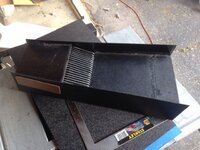
Nice little test size. We'll see how it works. Here's a shot of the magnetic profile.
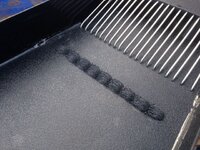 .
.
So where does it go? Over? Under? Straight through? Some, all or none of the above.?
The fabrication experiment is moving along. I'm tending back toward a near clone of the BGT. A few mods have worked out and others haven't.
The Bazooka is a great product. Not a lot of changes are needed. A total reworking is interesting but I'll wait to see the results.
I've been thinking about sizes. After the first build I went small for the 2nd.

Nice little test size. We'll see how it works. Here's a shot of the magnetic profile.
 .
.arizau
Silver Member
- May 2, 2014
- 2,518
- 3,947
- Detector(s) used
- Beach High Banker, Sweep Jig, Whippet Dry Washer, Lobo ST, 1/2 width 2 tray Gold Cube, numerous pans, rocker box, and home made fluid bed and stream sluices.
- Primary Interest:
- Prospecting
Ok fellow fluid-heads. I want to know, where does the fine gold go? There's been endless discussion different sluiced maybe have different recovery rates And that Bazookas lose the fine gold.
So where does it go? Over? Under? Straight through? Some, all or none of the above.?
The fabrication experiment is moving along. I'm tending back toward a near clone of the BGT. A few mods have worked out and others haven't.
The Bazooka is a great product. Not a lot of changes are needed. A total reworking is interesting but I'll wait to see the results.
I've been thinking about sizes. After the first build I went small for the 2nd.
View attachment 1442833
Nice little test size. We'll see how it works. Here's a shot of the magnetic profile.
View attachment 1442834.
Most everything that is less than the grizzly opening size enters the box. From there a combination of Mass and Shape pretty much determines what stays in the trap. Minus 100 mesh gold is almost always pretty flat (and foil thin) and flat shapes have the slowest settling velocity compared to more rounded pieces of the same diameter. If the material is slow to settle then it is likely to get caught in the flow through current and be washed out of the box. The answer is more complex than what I described but those are a couple of the basic principles.
Good luck.
Last edited:
goldog
Hero Member
- Sep 25, 2012
- 923
- 987
- Detector(s) used
- Bazooka Gold Trap, A-51, Gold Pan
- Primary Interest:
- Prospecting
- Thread starter
- #76
Just what I was looking for. Thanks Arizau! So I'll go with that.
As you made a few assumptions I'll start there. Small material enters through the grizzly. If not over fed, the heavies go in. Next the trap is working. Meaning there is adequate water fed through the tubes.
So we'll state the fine gold in question enters the trap, which is working, but nonetheless fails to settle due to "lightness". (Combination of small and thin.)
Of course the other side of the coin is boiling. The possibility of having so much action that gold will make its way through due to scouring. Some models have this issue if run too steep.
As you made a few assumptions I'll start there. Small material enters through the grizzly. If not over fed, the heavies go in. Next the trap is working. Meaning there is adequate water fed through the tubes.
So we'll state the fine gold in question enters the trap, which is working, but nonetheless fails to settle due to "lightness". (Combination of small and thin.)
Of course the other side of the coin is boiling. The possibility of having so much action that gold will make its way through due to scouring. Some models have this issue if run too steep.
Goodyguy
Gold Member
- Mar 10, 2007
- 6,489
- 6,900
- Detector(s) used
- Whites TM 808, Whites GMT, Tesoro Lobo Super Traq, Fisher Gold Bug 2, Suction Dredges, Trommels, Gold Vacs, High Bankers, Fluid bed Gold Traps, Rock Crushers, Sluices, Dry Washers, Miller Tables, Rp4
- Primary Interest:
- All Treasure Hunting
Most everything that is less than the grizzly opening size enters the box. From there a combination of Mass and Shape pretty much determines what stays in the trap. Minus 100 mesh gold is almost always pretty flat (and foil thin) and flat shapes have the slowest settling velocity compared to more rounded pieces of the same diameter. If the material is slow to settle then it is likely to get caught in the flow through current and be washed out of the box. The answer is more complex than what I described but those are a couple of the basic principles.
Good luck.
That is why a diverter baffle is so important. Trouble is, a diverter baffle has it's own problems. Scouring is a problem if the flow is fast and if the flow is slow it does nothing.
I found that a damper flap works better at slowing down the gold and knocking it out of suspension than a hard baffle without the problem of scouring and is not so sensitive to flow speed.
Up to now I have been using a single long flap suspended from the front of the trap cover..............
Here is an idea that I have not tried yet but may be an improvement over the single flap idea.
Think of a staggered series of damper flaps hanging down under the trap cover running the entire length of the trap that are cut into strips. Any material entering the trap must pass under the gauntlet of flaps like a car going through a car wash. I do not see how any self respecting shape or size of gold would not be slowed down and knocked out of suspension by that configuration.

Go For the Gold
GG~
Last edited:
Goodyguy
Gold Member
- Mar 10, 2007
- 6,489
- 6,900
- Detector(s) used
- Whites TM 808, Whites GMT, Tesoro Lobo Super Traq, Fisher Gold Bug 2, Suction Dredges, Trommels, Gold Vacs, High Bankers, Fluid bed Gold Traps, Rock Crushers, Sluices, Dry Washers, Miller Tables, Rp4
- Primary Interest:
- All Treasure Hunting
I know what you mean. When I first got into fluid beds I was turning everything that would hold water into one, as well as trying out all sorts of fluidizing gizmos including experimenting with different types of lawn sprinklers and spray heads. I must have built at least 50-60 different styles and types of fluidbed traps including one out of an old mailbox.
Found out it's hard to build one that wont recover gold. It's shooting for perfection that makes it challenging.
For $2.98 at Lowes This works pretty good in the bottom of a bucket (face the spray down of course) I experimented drilling holes in the inside edge and outside edge too. Turns a bucket of sand into quicksand.
View attachment 1438234
Had the idea of running several of them sideways in a large tube style trap but never tried it out...........
Might even work in a gold pan with a bilge pump attached to convert into a fluid bed gold pan. (panzooka)
GG~
I forgot to add stainless steel gas grill burners as some of the things I used to experiment with as fluidizing tubes. In fact that's what I used on the mail box.

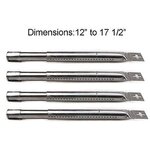
GG~
goldog
Hero Member
- Sep 25, 2012
- 923
- 987
- Detector(s) used
- Bazooka Gold Trap, A-51, Gold Pan
- Primary Interest:
- Prospecting
- Thread starter
- #80
Here's a bit from CaptNemo from his Bucket Buddy thread.
Displacement waves. What a concept. I felt this was relevant here so here goes.
The idea that in addition to the factors mentioned above there is an additional force at work. We all know this is the whole point of most capture methods. Get rid of what's lighter and keep what's heavier. (We'll leave our adhesion for this discussion).
In this context though, I want to focus more on feed rate. His premise was too much displacement allows more gold to escape.
In search of the most efficient fluidbed this should be addressed. A longer deeper trap is one approach. This seems like a no-brainer. Mostly that's true. Like all things it's good to a point. I would imagine the limitations would include both length and depth.
A longer trap increases the time and therefore the chance gold will settle to the bottom. You're limited by the amount you want to carry among other considerations. The 36" box was nice but my 30" BGT did almost as well with less. Besides the weight the water required was increased and cleanup was a little more difficult. An extra quart of concentrates means more work as well.
Depth has its limits too. There comes a point where you can't liquefy the material in the box due to weight. This is only a few inches above the tubes in most setups and that's being generous. The stream generated force is quite limited. A pump is impractical so we won't go there for this discussion. The fluidbed trash can high banker thread is nearby if "there" is where you want to go. For our purposes an inch or two above the pipes is all we got.
The diverter comes into play to coerce the gold down. The almost unnoticeable strip inside the trap "roof" creates a downward flow and possibly other effects. I increased this on the original build to double thickness. (A half inch instead of a quarter.) Goodyguy suggested a "car wash style" baffle/diverter. My latest build incorporates this.
Thanks Kevin!
Building a recirc fluid bed is easy, but optimizing it for conditions is the hard part. If I can get them to nail the finest beach sands then they'll catch everything else. The above failure proves that there's gold flying around the bed like glitter off a stripper. Get it too high in the bed, and you loose it. My best guess is the gold may be moving in the bottom 3" of the bed, and the 5 1/2" deep bed holds it. Create a condition where that fluidized gold can move higher, and you have loss. So you have to keep displacements small. That might be part of the problem with gold traps and -150 gold. They're too shallow to handle the displacement waves caused by shoveling into them. Keeping a steady flow of material would also minimize the effects of displacement waves.
Displacement waves. What a concept. I felt this was relevant here so here goes.
The idea that in addition to the factors mentioned above there is an additional force at work. We all know this is the whole point of most capture methods. Get rid of what's lighter and keep what's heavier. (We'll leave our adhesion for this discussion).
In this context though, I want to focus more on feed rate. His premise was too much displacement allows more gold to escape.
In search of the most efficient fluidbed this should be addressed. A longer deeper trap is one approach. This seems like a no-brainer. Mostly that's true. Like all things it's good to a point. I would imagine the limitations would include both length and depth.
A longer trap increases the time and therefore the chance gold will settle to the bottom. You're limited by the amount you want to carry among other considerations. The 36" box was nice but my 30" BGT did almost as well with less. Besides the weight the water required was increased and cleanup was a little more difficult. An extra quart of concentrates means more work as well.
Depth has its limits too. There comes a point where you can't liquefy the material in the box due to weight. This is only a few inches above the tubes in most setups and that's being generous. The stream generated force is quite limited. A pump is impractical so we won't go there for this discussion. The fluidbed trash can high banker thread is nearby if "there" is where you want to go. For our purposes an inch or two above the pipes is all we got.
The diverter comes into play to coerce the gold down. The almost unnoticeable strip inside the trap "roof" creates a downward flow and possibly other effects. I increased this on the original build to double thickness. (A half inch instead of a quarter.) Goodyguy suggested a "car wash style" baffle/diverter. My latest build incorporates this.
Top Member Reactions
-
 3540
3540 -
 2084
2084 -
 2062
2062 -
 1163
1163 -
 1116
1116 -
 928
928 -
 850
850 -
 823
823 -
 818
818 -
 782
782 -
 770
770 -
 548
548 -
 531
531 -
 453
453 -
 452
452 -
 446
446 -
E
424
-
 413
413 -
 408
408 -
 404
404
Users who are viewing this thread
Total: 2 (members: 0, guests: 2)


